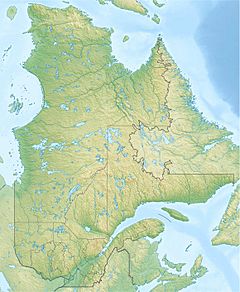Véco River facts for kids
Quick facts for kids Véco River |
|
|---|---|
| Other name(s) | Rivière Véco |
| Country | Canada |
| Province | Quebec |
| Region | Côte-Nord |
| RCM | Le Golfe-du-Saint-Laurent |
| Physical characteristics | |
| River mouth | Gulf of Saint Lawrence 0 metres (0 ft) 50°59′53″N 58°58′53″W / 50.99805°N 58.98139°W |
| Length | 80 kilometres (50 mi) |
| Basin features | |
| Basin size | 1,016 square kilometres (392 sq mi) |
The Véco River (also known as French: Rivière Véco in French) is a river in Quebec, Canada. It is well-known for its salmon and flows into the Gulf of Saint Lawrence. A dam on the river helps create electricity for a power plant. The area around where the river meets the sea is a special protected place for birds.
Contents
Where is the Véco River Located?
The Véco River is about 80 kilometers (50 miles) long. The area it drains, called its watershed, covers about 1,016 square kilometers (392 square miles). The river gets its water from lakes like Lake Robertson, Lake Charles, and Lake Blais. It eventually flows into a place called Ha! Ha! Bay.
The river flows through an area known as Petit-Mécatina. Its mouth, where it meets the Gulf of Saint Lawrence, is in the town of Gros-Mécatina. This town is part of the Le Golfe-du-Saint-Laurent region.
What Does the Name Véco Mean?
The Véco River is named after Jean-Baptiste Véco. He was a notary-royal, which is a type of public official, in Acadia during the 1600s.
How the Véco River Helps Make Electricity
A large dam built by Hydro-Québec is located on the Véco River. This dam created the Robertson Reservoir, which includes what used to be Lake Robertson and Lake Plamondon. This reservoir helps power the Lac-Robertson Generating Station.
The power plant started working in 1995 and can produce 22 megawatts of electricity. When the dam was built and the area was flooded, it caused some changes in the water. For example, the amount of mercury in the lake water increased. This happens when plants and other organic materials in the flooded area break down, releasing mercury into the water. This mercury can then enter the food chain. These changes might have affected the water quality in the Véco River and Ha! Ha! Bay.
Protecting Nature Around the River
There are plans to create a special protected area called the Harrington Harbor Biodiversity Reserve within the river's watershed. This would help protect the different plants and animals in the area.
A very important place for birds is the Gros-Mécatina Migratory Bird Sanctuary. This sanctuary includes several islands like Plate Island, Trois Collines Island, and the Marmette Islands and Rocks. This area is fully protected, and people are not allowed to enter it. The Canadian government owns this land, and it is protected by laws like the Migratory Birds Convention Act and the Canada Wildlife Act. The parts of the Gros Mécatina River and the Véco River that are affected by tides are also managed by this bird sanctuary.
Fishing and River Life
The Véco River is a vital place for fish. It is a spawning ground, meaning fish come here to lay their eggs. Two important fish species that use the river for spawning are Atlantic salmon (Salmo salar) and brook trout (Salvelinus fontinalis).
Other fish found in the area include Arctic char (Salvelinus alpinus), which has been seen in Robertson Lake. The mouth of the Véco River in Ha! Ha! Bay is home to fish like rainbow smelt (Osmerus mordax), Atlantic tomcod (Microgadus tomcod), and American eel (Anguilla rostrata).
Some companies, like Pourvoirie Kecarpoui, organize fishing and camping trips that include the Véco River and other nearby rivers. From 2012 to 2016, about four salmon were caught in the Véco River each year. In 2017, new rules were put in place for salmon fishing on several rivers, including the Véco River. For that year, all salmon, no matter their size, had to be released back into the Véco River.


